15.11.2004
M.Dvoretsky. Positional sacrifice of the Queen (continuation 4)
Augustin – Nunn C26
Team championship of Europe, Moscow 1977
(on the basis of the commentary by John Nunn from the book "Secrets of Grandmaster Chess")
1.e2-e4 e7-e5
2.¤b1-c3 ¤g8-f6
3.g2-g3 Ґf8-c5
4.Ґf1-g2 d7-d6
4...¤c6 is more accurate, and to 5.d3 Nunn recommends 5...a6, having guaranteed a retreat of the bishop in case of ¤a4.
Over next couple of moves, both sides have to make a key decision. Should Black prevent White from forcing the exchange of the c5-bishop by ¤a4 and, if Black allows it, should White accept the offer? Now I think that both players misassessed this exchange.
I wasn't too worried by the possibility of ¤a4, because I was aware of the example Larsen – Portisch (Candidate's match 1968), in which a similar position arose with colours reversed. That game has begun 1.e4 e5 2.¤c3 ¤c6 3.Ґc4 ¤f6 4.d3 ¤a5 5.¤ge2 ¤:c4 6.dc Ґe7 7.0-0 d6. White later gained the advantage based on his outpost at d5 and because Black could not readily prepare ...f5 (the only plausible plan) to open up the game for his bishop pair. Moreover, White still retained the option of ¤g3, making ...f5 even harder to achieve.
A decisive 19th game of the match Larsen – Portisch was continued as follows: 8.b3 0-0 [8...Ґe6!? 9.¤g3 ¤d7] 9.¤g3 c6 10.Ґb2 Јa5 11.Јe1 Јc7 12.a4 Ґe6 13.¦ad1 a6 14.Јe2 Ґg4?! [14...¦fd8 with subsequent ¤e8, Ґf8, f6, Јf7] 15.f3 Ґd7 16.ўh1 ¦ab8 [16...g6] 17.¤f5 Ґ:f5 18.ef ¦fe8 19.¦d2 ¦bd8 20.¦fd1 ¤h5? [20...g6; 20...Јc8 21.g4 g6] 21.Ґa3 ¤f4 22.Јf2 Јa5? 23.¤e4 d5 24.Ґ:e7 ¦:e7 25.Јh4 ¦ed7 26.g3 ¤e2 27.f6 Јb4 28.Јg4 Black resigned (short comments in brackets – by Svetozar Gligoric).
Accordingly, I intended simply to allow ¤a4 and ¤:c5. However, the situation in the present game is somewhat different because White has not yet committed his knight to f3 and so he could have played ¤e2 and d3, preparing a quick f4. ›he opening of the game for White's bishops would have counted for more than Black's control of d4.
After 5.¤a4 Black's best scheme of development would be ...h6, ...Ґe6, ...¤c6 and ...Јd7, reserving the option of 0-0-0 to move the king to safer spot in case White aims for f4. However, even in this case White could count on an edge.
5.¤g1-e2 ¤b8-c6
6.0-0?!
It's a serious positional mistake that transmits the initiative to the opponent (here as well as in the previous move ¤a4 should be played). In such positions (when a black bishop is at с5) it's possible to castle when a white knight is at f3, and if a knight is at e2, it's possible only after Black has made a short castling.
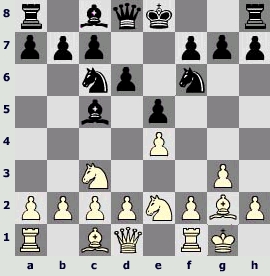
6. . . . h7-h5!
That is the point, it's surprisingly not easy to defend against such a straight attack.
7.d2-d3
Other continuations can also be found.
I. In the game Toth – Vidmar that was played at the championship of Yugoslavia in 1946 White got a difficult position after 7.¤d5?!h4 8.d4 ¤:d4 9.¤:d4 Ґ:d4 10.Ґg5 hg 11.hgc6 12.¤:f6+ gfµ.
II. Incaseof7.h4?!Black got an important square g4. He would continue 7...a6 with subsequent Ґg4, Јd7, 0-0-0 (Nunn).
III. In case of7.h3 it would be necessary to reckon with the sacrifice of a piece 7...h4 8.g4 ¤:g4, however Nunn considers it to be incorrect. After 9.hg there are two possible ways of attack for Black:
А) 9...h3 10.Ґf3 Јh4 11.ўh1 [11.ўh2!? (Dvoretsky)] 11...Ґ:f2 12.d3 Ґb6 [12...¤d4? 13.¤:d4 ed 14.¤d5ќ] 13.g5± и 14.¤d5. Instead of 11...Ґ:f2 stronger are 11...Ґ:g4 12.Ґ:g4 Ј:g4 13.¤g3 (here in the opinion of Nunn the attack comes to a dead-lock) 13...Ј:d1 14.¤:d1 ¤b4 15.c3 ¤d3, and in spite of the exchange of queens Black keeps a sufficient compensation for a piece (Dvoretsky).
B) 9...Ґ:g4 10.ўh2 g5?! 11.¤d5 Ґe6 12.f3 h3 13.Ґh1 f5 14.b4! with an advantage of White (Motvani – MacKay, Edinburgh 1988). The attack is intensified by 10...h3 11.Ґh1 Јh4 12.f3 Ґe6. Black is preparing a long castling, on occasion there is a move Ґf2 – in general a position seems to be unclear (Dvoretsky).
Certainly it is not necessarily to sacrifice the bishop, it's possible to play simply 7...Ґe6.
To 8.¤d5 Nunn points 8...Ґ:d5 9.ed ¤e7 10.¤c3 Јd7і, but instead of passive 10.¤c3? Whiteplays 10.d4! ed 11.¤:d4. However he shouldn't be hasty with exchange at d5, 8...Јd7 is stronger.
Nunn analyzes a variant 8.d3 Јd7 9.ўh2 0-0-0 10.Ґg5 [10.f4? ¤g4+] 10...¦dg8 with subsequent ¤h7 and g7-g5.
And the game van Mil – Timmermans, team championship of Belgium 1997, was developing like that: 8.¤a4 Јd7 9.¤:c5 dc 10.ўh2 h4 11.g4 0-0-0 12.b3 ¤h7 13.f4 ef 14.¤:f4 ¤g5 15.d3 f6 16.Ґe3 Јd6 17.ўh1 ¤e5 18.a3 Јc6 19.¤d5? ¦:d5!і.
IV. Lastly, White could exchange the strong bishop by the move 7.¤a4, to what Black responded 7...h4 [7...Ґb6?! 8.¤:b6 ab 9.d4 are worse] 8.¤:c5 dc 9.d3 hg, and each recapture has its own drawback:
10.hgҐe6, and then Јd7, 0-0-0 with a dangerous attack (Razovsky – Pokorny, Bad-Pishtjan 1922);
10.fgҐg4 11.Ґe3 ¤d4 12.Ґ:d4 cdµ (Majeric – Velimirovic, Championship of Yugoslavia 1980);
10.¤:g3 ¤g4 11.h3 Јh4 [11...¤f6!?іis simpler (Dvoretsky)] 12.¤f5 Ґ:f5 13.ef ¤h6 [13...¤d4? 14.c3!ќ] 14.Ґ:c6+ bc 15.Јf3 0-0-0!, and a draw is the most probable result after 16.Ј:c6 Ј:h3 17.Јa8+ ўd7 18.Јd5+ ўc8.
7. . . . h5-h4
8.Ґc1-g5

8. . . . h4:g3!?
Black had a worthy alternative: 8...Ґg4!?. A response 9.Ґ:h4?! ¤d4 10.h3 won't work [10.Јd2 ¤f3+ 11.Ґ:f3 Ґ:f3 12.Јg5! Јd7 13.Јf5 Ј:f5 14.ef ўd7!? isn't much better, and the attack remains even in the ending (Dvoretsky)] 10...¤f3+ 11.Ґ:f3 Ґ:f3 12.Јd2 Јd7 13.ўh2 ¤g4+! with a defeat.
In the game Smyslov – Kotz, Championship of the USSR, Baku 1961, White chose 9.Јd2 hg 10.¤:g3 Јd7 [10...¤d4!? deserved attention and then depending on the circumstances: ¤e6; ¤f3+; Ґf3; c6 (Dvoretsky)] 11.Ґ:f6 gf 12.¤d5 (according to "Encyclopaedia of chess openings" White has an advantage) 12...0-0-0 13.¤:f6
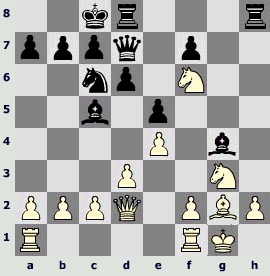
Yuri Kotzplayed 13...Јe7? 14.¤:g4 Јh4, and after 15.Јd1 ¦dg8 16.¤f5 Ј:g4 17.Ј:g4 ¦:g4 18.c3± White simplified the position, having kept an extra pawn. This is universally given as good for White (even in "Secrets of Grandmaster Play!" – the first edition of the Nunn's games collection), but Black has a massive improvement.
13...Јe6! 14.Јg5 Ґh3 15.Ґ:h3 [15.Ґf3 ¤d4 16.Ґg4 Ґ:g4 17.Ј:g4 Ј:g4 18.¤:g4 ¦h4!µ; 15.¤f5 ¤d4!µ] 15...¦:h3 16.Јf5 ¦dh8, and Black is in a difficult situation.
Thus Black has two fully adequate continuations, and so this whole line is a complete non-starter for White.
My idea in exchanging immediately on g3 was to see which way White intends to recapture and adapt my reply accordingly. It is hard to fault this logic.
9.¤e2:g3
9.hg is obviously risky, since it present Black with an automatic attack after 9...Ґg4 10.Јd2 Јd7.
To11.Ґ:f6 gf 12.¤d5 Nunn points 12...0-0-0 13.¤:f6 Јe6 14.¤:g4 Ј:g4 15.c3 Јh5 16.¦fe1 f5 17.d4 f4! With a verydangerousattack.
But after 11.¤a4 Nunn, as it seems to me, slightly underestimates the strength of the position of Black contrary to his estimation that is given in the beginning of the comment.
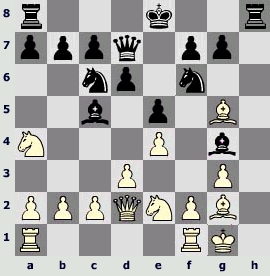
So he considers the move 11...Ґf3 to be incorrect in view of 12.Ґ:f3 [12.¤:c5? Јh3! leads to a checkmate] 12...Јh3 13.Ґh4 ¦:h4 14.ghЈ:f3 15.¤:c5 ¤g4 16.¤g3, and the attack fizzles out. Let's withdraw the last move of Black in favour of 15...¤d4! 16.¤:d4 Јg4+ 17.ўh1 Ј:h4+ 18.ўg2 Јg4+ 19.ўh1 0-0-0 20.f3 ¦h8+ 21.Јh2 ¦:h2+ 22.ў:h2 Јh4+ 23.ўg2 ed24.¤b3 ¤h5 with a won position or 16.¤g3 Јg4! 17.Јd1 Јh3!, and Black has a great advantage, because after an inevitable 18...¤g4 the queen is to be sacrificed for the knight.
The main variant of Nunn is 11...Ґh3 12.¤:c5 dc 13.f3 Ґ:g2 14.ў:g2 Јh3+ 15.ўf2 Јh2+ 16.ўe1 ¤d4, and Black is slightly better. Butthelastmoveisn't precise: 16...0-0-0 or 16...¤d7!? are far more unpleasant for the opponent, preparing f7-f6.
Finally, Black has at his disposal a third opportunity, which is at least not worse than the previous ones: 11...Ґ:e2!? 12.¤:c5 [in case of 12.Ј:e2 ¤d4 White loses the knight а4] 12...Јg4 (the danger of 13...¤d4!) 13.¤b3 [13.f3 Ј:g3 14.Ј:e2 Ј:g5 are hopeless] 13...Ґ:f1 and 14...0-0-0 – White doesn't have any compensation for the lost exchange.
9. . . . ¤c6-d4!
This is a precise response to the knight recapture on g3. By threatening to seize control of the weak point at f4 after ...¤e6, Black forces his opponent to take some immediate action before the grip tightens.
10.¤g3-h5
By this move White starts combination that however doesn't provide him a desirable benefit. Nunn analyzes the following alternatives:
Tseitlin and Glazkov suggest the strange move 10.h4, but it is impossible to imagine what they intend to play if Black just executes his threat of 10...¤e6.
10.b4 is another oddity from Tseitlin and Glazkov. After 10...Ґ:b4 11.¤d5 ¤:d5! 12.Ґ:d8 ¤c3 13.Јe1 ¤ce2+ 14.¤:e2 Ґ:e1 15.¤:d4 ў:d8 Black is just a pawn up in the ending.
(I'mnotsureinappropriateness ofthe combination of names of Tseitlin and Glazkov, because it was Jakov Estrin who usually collaborated with I.Glazkov who was known for his love to “open” openings.)
10.¤d5(the soundest move) 10...c6 [10...¤e6 11.¤:f6+ gf 12.Ґe3 is also roughly even] 11.¤:f6+ gf 12.Ґe3. Here Black cannot transfer his queen with any effect to the h-file, for example 12...f5 [the alternative 12...¦h4, intending ...Ґg4, is also level] 13.ef Јh4 14.h3 ¤:f5 15.Ґ:c5 dc 16.Јe2 f6 17.Јe4 ¤d6 18.Ј:h4 ¦:h4 19.¦ae1 Ґ:h3 20.f4 is equal.
"Encyclopedia of chess openings"suggests 10.¤a4 (with the mark !?), but after 10...Ґg4 11.Ј:g4 [11.Ґ:f6 Јc8 12.Јd2 gf 13.¤:c5 ¤f3+ 14.Ґ:f3 Ґ:f3 leads to inevitable checkmate] 11...¤:g4 12.Ґ:d8 ¦:d8 13.h3 ¤f6 Black has a noticeably better ending.
10. . . . ¤d4-e6
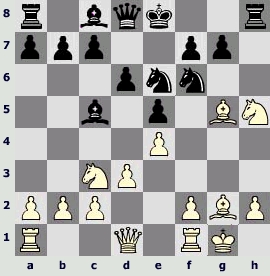
11.¤h5:g7+!?
When my opponent played this move I was completely stunned, because I hadn't noticed it at all. Readers may be feeling that this comment is a recurrent theme in the book, and may have concluded that I am gifted with extraordinary luck. However, I feel that there is more to it than that.
If one's position has been constructed on a sound basis, then the chances that it will be demolished by a random tactic are rather small – it can happen, of course, and ideally one should check all such possibilities. However, it can be very time-consuming to look for tactical lines every single move, and at some point one has to trust one's intuition that there won't be an unexpected knock-out blow. Don't believe that grandmasters look at everything!...
In this case my oversight was doubtless due to the fact that I was concentrating on lines involving pressure on f6, and the blow on g7 was somehow "non-thematic" and hard to see.
Let's have a look at other possibilities of White.
I. 11.¤:f6+ gf 12.Ґe3f5 [I think that a simple 12...c6!? provides an advantage to Black (Dvoretsky)] 13.ef [13.Ґ:c5? Јh4! 14.h3 ¤f4 lose] 13...Јh4 [13...¤d4!?іisn't bad with the idea of c7-c6 (Dvoretsky)] 14.h3 ¦g8 15.Јf3 [15.ўh1 ¤d4 leads to a difficult position (the danger of 16...Ґ:f5)] 15...¤g5 16.Ґ:g5 ¦:g5 17.¤e4 ¦:f5 18.Јg4 Јh8! 19.¤:c5 dc 20.Ґ:b7 ¦f4

21.Ґc6+ ўf8 22.Јg3 ¦b8 followed ¦b6, withaverystrongattack. It's correct, but how to estimate the situation that arises after 21.Ј:f4! ef [21...Ґ:b7? 22.¦fe1 0-0-0 23.¦:e5 won't do] 22.Ґ:a8› ? (Dvoretsky).
However taking into account my comment to the 12th move it's possible to conclude that the exchange 11.¤:f6+ still isn't sufficient for an equality.
II. 11.Ґ:f6 gf 12.¤d5 ¦h6
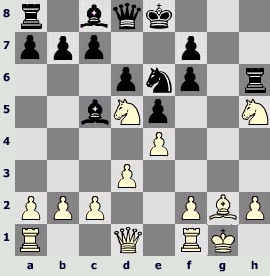
А) 13.Јf3 ¤d4!, and loses 14.¤h:f6+? ўf8 15.Јe3 ¦:f6 16.Јg5 ¤f3+! 17.Ґ:f3 ¦g6.
B) 13.b4Ґb6 14.¤:b6 ab 15.f4 ўe7µ with subsequent 16...Јh8. Or 14.Јg4 (a recommendation of A.Konstantinopolsky and V.Lepeshkin) 14...ўf8 15.¤:b6 ab 16.f4 ўe7!, and both in case of 17.f5 ¤d4 and after 17.fedethe danger of 18...Јh8 provides Black with an overwhelming advantage.
C) 13.c3c6 14.¤e3 Ґ:e3! 15.feўe7!µ.
D) 13.¤e3Ґ:e3! (at first sight it is crazy to open the f-file and improve White's pawn structure, but this gains time for Black to develop his kingside initiative)14.fe ўe7! 15.¤g3 ¤g5 and White cannot use the f-file in any effective way, yet Black can use the g- and h-files. Furthermore, Black's king is quite secure at e7, while White's is not. If White continues 16.¤f5+ Ґ:f5 17.¦:f5, then after 17...Јh8 White loses his h-pawn, while against other moves Black just develops his initiative by the natural moves ...Јh8, ...Ґe6 and ...¦g8.
The conclusion is that the alternatives are no better than the move played, since in none of the above lines does White have clear equality.
11. . . . ¤e6:g7
12.¤c3-d5 ¤f6:d5!
The sacrifice of the queen for two light pieces is very strong. Let's analyze the consequences of the alternative: 12...¤gh5 13.¤:f6+ ¤:f6 14.Јf3 Ґg4 15.Ј:f6 Ј:f6 16.Ґ:f6 ¦h5.
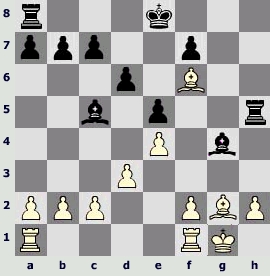
White should assume measures against ўd7-e6.
А) 17.c3?Ґe2 is not correct.
B) To 17.ўh1 17...ўd7 is not a good response in view of 18.f3! Ґe6 [18...Ґh3 19.Ґ:h3+ ¦:h3 20.f4 ўe6 21.fede 22.¦f5±] 19.f4, and White maintains his bishop in a strong position. Better is 17...Ґe2 18.¦fe1 Ґg4 19.f3 [or 19.¦f1 Ґe2 with a repetition of moves] 19...Ґe6 (the danger of Ґf2-g3) 20.¦e2 [20.¦f1? Ґe3is not advantageous] 20...ўd7 21.c3 ¦h6 22.Ґg5 ¦h5, and a draw apparently cannot be avoided: 23.Ґf6 ¦h6= or 23.Ґd2 ¦ah8 24.Ґf1 ¦g8 25.Ґg2 [but not 25.¦g2? ¦:h2+! with a checkmate] 25...¦gh8=.
C) 17.h4!? (at first sight this looks ridiculous, but it appears to give White the advantage)17...ўd7 18.ўh2 ¦g8! [to 18...ўe6 Nunn points 19.f3 Ґh3!? 20.ў:h3 ў:f6 21.f4 ¦ah8 22.fe+ ў:e5 23.¦:f7Іor 22...ўe7 23.¦f5І – in both cases White has an extra pawn] 19.f3 Ґe6 20.f4
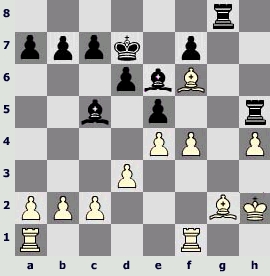
Nunn continues the variant as follows: 20...ef 21.¦:f4 Ґe3 22.¦f3 Ґg5 23.Ґ:g5 ¦g:g5 24.¦f4 with advantage of White having maintained an extra pawn.
But the play of Black is strengthen by the move 20...¦h6!. If 21.f5, then 21...Ґ:a2! 22.¦:a2 ¦:f6, and White has a noticeably worse position. To 21.fe it's possible to respond 21...Ґd4!, because an attempt of exchange of white-square bishops 22.Ґh3? is refuted by 22...¦:f6! 23.ef Ґ:e5+ 24.ўh1 Ґ:h3°. Lastly, in case of 21.Ґg5 Black sacrifices an exchange 21...¦:g5 22.fg ¦:h4+ 23.ўg3 ¦g4+ [to 23...¦h5 it's possible 24.¦f3, in order to exchange bishops by the move 26.Ґh3 after 24...¦:g5+?! 25.ўh2] 24.ўh2, and now either 24...¦h4+ with a draw or 24...Ґe3!?.
However taking into account that in case of 17.ўh1 Black didn't lay claim to anything more than a draw, one can agree with Nunn's conclusion: It follows that the move played is definitely best, as after it White has no clear route even to a draw.
13.Ґg5:d8 ¤d5-f4
14.Ґd8-g5
All the rest is absolutely hopeless: 14.Ґ:c7? ¤ge6, or 14.Ґf6? ¦g8 15.ўh1 [15.Ґh4 ¤gh5 16.Ґg3 ¤:g3 17.hg ¦:g3] 15...¤gh5.
14. . . . ¤g7-e6
15.Ґg5:f4 ¤e6:f4

A bishop and a knight is not a great deal to compensate for a queen and a pawn, but there are several factors operating in Black's favour. The two open files leading to White's king and the tremendous outpost at f4 are the most obvious, but it also important that none of White's pieces are likely to display activity in the near future. Open files for White's rooks are hard to come by and his bishop is particularly useless. White's queen is relatively ineffective because there are no real targets in Black's position, and White's other pieces are unable to co-operate with the queen.
White's only real chance for activity is to play c3 and d4, which will both shut out the bishop on c5 and offer White the possibility of opening the game up, which will benefit the queen. Whether or not this succeeds depends on the time element: can Black swing his a8-rook into the attack before White manages to advance in the centre? Every tempo is crucially important.
Without the help of c3 and d4 White would have no chance at all, but even taking this possibility into account White is still in difficulties. Immediate threat is 16...¦g8, and White has two reasonable defences: 16.Ґf3 and 16.ўh1.
16.ўg1-h1
It seems that neither defence is really adequate, so there is no reason to criticise this move. The problem with this voluntary king move is that in some lines it costs White a tempo. One of Black's main attacking plans is to double rooks on the h-file and take on h2. If White leaves his king on g1, then Black throws in ...¦g8+ before doubling rooks, in order that the capture on h2 is with check. However, this means that Black has to play three rook moves before he is doubled. If White plays ўh1 voluntarily, then Black can omit ...¦g8+ and double his rook in only two moves.
The alternative 16.Ґf3 has the defect that it prevents the white queen from joining the defence, for example by Јf3-g3 to cover the weak h2-pawn. The result is that White still faces a very difficult defensive task, as the analysis of 16.Ґf3 demonstrates.
An interesting task: try to choose intuitively the strongest continuation of Black's attack.
I. 16...¤h3+? 17.ўh1 ¤:f2+ 18.¦:f2 Ґ:f2 19.Ґg4± is very good for White.
II. 16...Ґh3
IIа 17.ўh1?Ґ:f1 18.Ј:f1 ¤h3µ;
IIб 17.¦e1 ўe7 18.Јd2 [18.ўh1 ¦h4 19.c3 ¦ah8 20.¦g1 Ґ:f2°] 18...¦h4 19.ўh1 ¦ah8 20.¦g1 Ґf1! 21.¦g:f1 ¦:h2+ 22.ўg1 ¦2h3 23.Ј:f4 (the only move) 23...ef 24.ўg2 ¦h2+ 25.ўg1 ¦2h6 26.¦fd1 ¦h3! with a clear advantage for Black.
IIв 17.c3 (White must prepare d4 at once) 17...ўe7 (a threat 18...¦ag8+ 19.ўh1 Ґg2+ 20.Ґ:g2 ¦:g2 is created with an inevitable checkmate) 18.ўh1 ¦h4 [18...¦ag8 19.¦g1; 18...Ґ:f1 19.Ј:f1 ¤h3 20.d4 ed 21.Ґg4±] 19.d4 ¦ah8 [19...Ґb6 20.¦g1 ¦ah8 21.¦g3 are of no use] 20.¦g1 (there was a danger of 20...Ґg2+) 20...Ґf1! [weaker are 20...Ґe6 21.¦g3 ¦:h2+ 22.ўg1 ed 23.cd Ґ:d4 24.Ј:d4 ¦h1+ 25.Ґ:h1 ¤e2+ 26.ўg2 ¤:d4І] 21.¦:f1 [21.¦g3? ¦:h2+ 22.ўg1 Ґe2 23.dc dc! with advantage of Black] 21...¦:h2+ 22.ўg1 ¦2h4 23.dc [23.¦e1 ¦g8+ 24.ўf1 ¦gh8 also lead to a draw] 23...¤h3+ [approximately equal ending arises after 23...¦g8+ 24.Ґg4 ¦g:g4+ 25.Ј:g4 ¦:g4+ 26.ўh2 ¦g2+ 27.ўh1 dc (Dvoretsky)] 24.ўg2 ¤f4+ 25.ўg1 [25.ўg3? ¦h3+ 26.ўg4 ўf6! withinevitablecheckmate] 25...¤h3+, the matter ends in a perpetual check.
III. 16...Ґe6! (Black avoids blocking the h-file) 17.c3 ўe7 18.d4
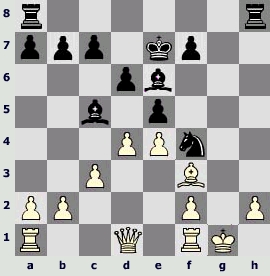
IIIа 18...¦h4(this direct attempt only leads to a draw) 19.dc ¦g8+. Three moves instead of two to get doubled; 19...¦ah8 would be even slower because the capture on h2 would not be check.
20.ўh1 ¦gh8 21.cd+ cd 22.¦e1 (theonly defence) 22...¦:h2+ 23.ўg1 ¦2h4 24.¦e3! Ґh3 [24...Ґc4 25.Ґg2 lead to the same position that arises in case of 24...Ґh3 25.Ґh1 Ґf1] 25.Ґh1! Ґg4 [25...Ґf1!? 26.Ґf3 Ґc4 27.Ґg2 ¤:g2 28.ў:g2 ¦h2+ 29.ўg1, and Black has only a perpetual check] 26.Ґf3. And now White is oddly paralysed; indeed he can only move his a1-rook or a pawn. However, there is no way to improve Black's position, and White can save himself by returning the queen.
26...¦8h6 27.¦c1 Ґh3 28.Ґh1 Ґf1 29.Ґf3 Ґc4 30.Ґg2 ¦g6 [30...¤:g2=] 31.¦g3 ¤e2+ 32.Ј:e2 Ґ:e2 33.¦:g6 fg, and White slips away into an equal ending.
IIIб 18...Ґb6! 19.ўh1 [19.de de 20.Јa4 ¦h3, queen checks are met by ...c5, whereupon Black wins material on the kingside] 19...¦h4 20.¦g1 ¦ah8 21.¦g2 [in case of21.¦g3 ¦:h2+ 22.ўg1 Black has a right to choose22...¤h3+ 23.ў:h2 ¤:f2+ 24.ўg2 ¤:d1 25.¦:d1 ed 26.cd Ґ:a2і,but he benefits more in case of 22...Ґc4 23.Јd2 Ґe2! 24.Јe3 c5! with overwhelming advantage (Dvoretsky)] 21...¤:g2 22.Ґ:g2 [22.ў:g2 ¦:h2+ 23.ўg1 ¦2h4°] 22...¦:h2+ 23.ўg1 ¦2h4 24.¦c1 ¦g8 25.f3 ed 26.cd c5!, and the position of White is difficult.
16. . . . Ґc8-e6
Certainly not 16...Ґh3? 17.Ґ:h3 ¦:h3 18.Јg4ќ. Black's correct plan is simply to round up the h-pawn, thereby completely exposing the white king.
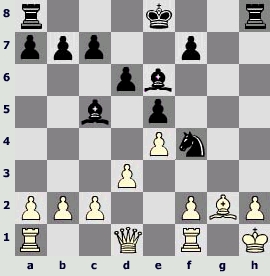
17.Ґg2-f3?
In the naïve hope to simplify the position by the move 18.Ґg4.
Last move, as we saw, this would be a reasonable defence, but now it loses quickly since White gets the worst of both worlds: he has played ўh1 voluntarily, and now he blocks f3 for the queen. White wants to use his rook along the g-file, but there is simply no time for this plan.
However, none of the alternatives proves adequate to maintain the balance.
17.c3(preparing d4) 17...0-0-0 (in most cases ...ўe7 is better, to avoid a check at g4, but here it makes no difference) 18.d4 ¦h4! 19.dc ¦dh8 20.Ґf3 [20.Јf3 ¦:h2+ 21.ўg1 ¦:g2+ 22.Ј:g2 ¤e2#] 20...¦:h2+ 21.ўg1 ¦2h4 22.¦e1 ¦g8+ 23.ўf1 Ґh3+ and Black wins.
17.Јf3 White's best defence, bringing the queen into play; the danger is that, with so little room to manoeuvre, it may get trapped.
17...ўe7 18.¦g1 ¦h6 [a perpetual checkafter 18...¦:h2+ 19.ў:h2 ¦h8+ certainly isn't convenient for Black] 19.Ґf1 ¦ah8 20.Јg3 [20.¦g2 Ґh3! 21.Јg3 Ґ:g2+ 22.Ґ:g2 ¦g6 loses immediately] 20...Ґg4! (this would be impossible had Black played 17...0-0-0; now there is a danger of 21...Ґ:f2 22.Ј:f2 Ґf3+)21.¦g2 ¤:g2
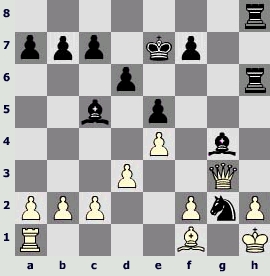
А) 22.ў:g2¦g8! 23.ўh1 [23.ўg1 ¦hg6°; 23.h4 ¦f6 24.ўh2 ¦f3°] 23...¦f6 24.Ґe2 Ґ:e2! 25.Ј:g8 ¦g6° [or25...¦:f2° (Dvoretsky)]
Б) 22.Ґ:g2¦g6 (there is a danger of 23...Ґe2) 23.¦e1 [23.f3 Ґe6 24.Јe1 ¦hg8°; 23.d4 Ґ:d4°; 23.f4 Ґe6 24.Јf3 ef 25.Ј:f4 ¦hg8µ] 23...Ґe6 24.Јf3 ¦f6 25.Јd1 ¦fh6 (there is a danger of 26...Ґ:f2) 26.ўg1 [26.¦f1 ¦:h2+ 27.ўg1 ¦2h6 28.¦e1 ¦g6 29.ўf1 ¦h2°] 26...¦g6 27.ўh1 Ґ:f2 28.¦f1 Ґg3 29.h3 Ґ:h3 30.Ґ:h3 ¦:h3+ 31.ўg2 ¦h2+ 32.ўf3 Ґh4°
В) 22.Ј:g2(relatively best, but still insufficient in the long run) 22...¦g6 [there is danger both of 23...¦hg8 and23...Ґh5 24.Јh3 Ґe2! 25.Ј:h8 (25.Јf5 Ґg4) 25...Ґf3+ 26.Ґg2 ¦:g2°] 23.Јg3 [23.f3 Ґ:f3] 23...Ґh5 24.Јh4+ [24.Јh3 Ґe2] 24...f6 25.Јh3 Ґ:f2 [weaker are 25...Ґe2 26.Јf5›] 26.Ґg2 ¦gh6 27.¦f1 Ґf7 28.Ј:h6 ¦:h6 29.¦:f2 Ґ:a2 30.b3 Ґb1!, with advantage to Black.
17. . . . ¦h8-h4!
Black prevents the move 18.Ґg4 and simultaneously prepares a doubling of rooks along the h-file.
18.¦f1-g1
In case of 18.c3 0-0-0 19.d4 ¦dh8 20.dc ¦:h2+ there arose the same won for Black position that in the case of 17.c3 (instead of 17.Ґf3) 17...0-0-0 18.d4 ¦h4 19.dc ¦dh8 20.Ґf3 ¦:h2+.
18. . . . ўe8-e7
19.¦g1-g2
19.¦g3 Ґ:f2 only makes matters worse, because the white king will be trapped at h1.
19. . . . ¤f4:g2
20.Ґf3:g2 ¦a8-h8

21.Јd1-d2
To 21.Јg1 21...¦f4 22.¦f1 Ґg4 and 23...Ґe2 decide.
21. . . . ¦h4:h2+
22.ўh1-g1 ¦h2-h4
Having digested the exchange and the h-pawn, Black prepares to line up against the next target: the bishop on g2.
23.¦a1-e1
In case of 23.ўf1 23...¦h1+ wins, but 23...¦g8! 24.Ґf3 ¦h2 are even more convincing with subsequent 25...Ґh3+. And if 23.Јg5+, then 23...f6 24.Јg7+ Ґf7 (the danger of 25...¦g8) 25.Јg3 ¦4h7! 26.ўf1 ¦g8 27.Јf3 ¦h2 28.Ґh3 Ґh5!, mating or picking up the queen.
23. . . . ¦h8-g8
24.¦e1-e3
24.ўf1 ¦h2 25.Ґf3 Ґh3+
24. . . . Ґc5:e3
25.Јd2:e3 Ґe6-h3
Black wins a piece while retaining his attack; the game is over.
26.ўg1-f1 Ґh3:g2+
27.ўf1-e2 c7-c5
28.Јe3-d2 b7-b6
29.Јd2-c3 ¦h4-f4
30.Јc3-a3 a7-a5
31.Јa3-b3 Ґg2-h3
32.f2-f3 ¦g8-g2+
33.ўe2-e3 Ґh3-g4!
After 34.fg ¦gf2 the checkmate 35...¦4f3 is inevitable. White resigned.
